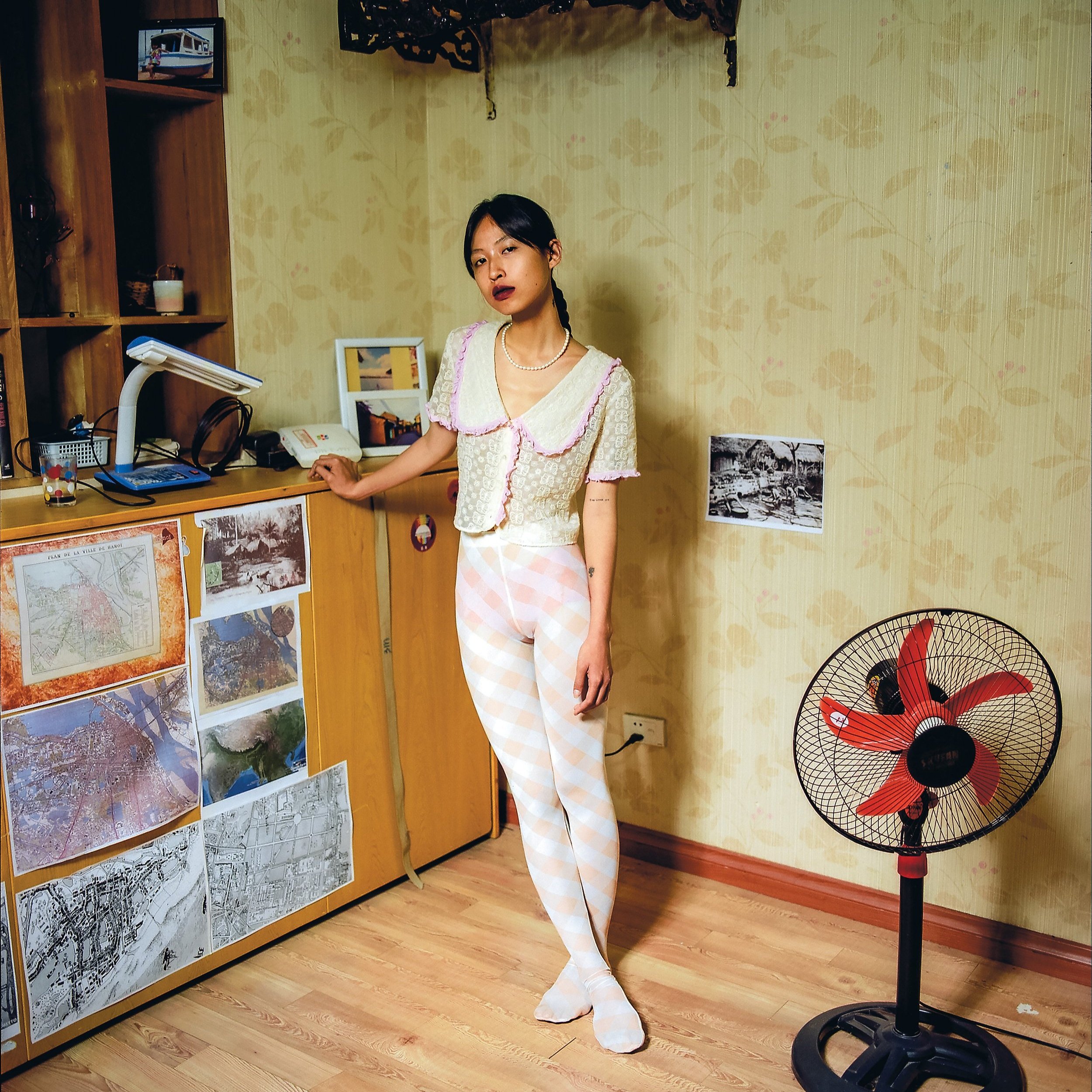Through the Lens: Nicholas See
Deconstructing masculinity with Buddhist symbolisms
By Sharrona Valezka
‘Through the Lens’ is a series that explores in detail images from fashion image-makers in Southeast Asia, shining a light on their creative and technical processes.
Nicholas See is a fashion stylist and film director based in Singapore. He is a recent graduate from the BA(Hons) in Fashion Media and Industries at LASALLE College of the Arts. His work often explores the themes of cultural narratives and diaspora. For this article, we ask Nicholas about his graduation project ‘An Asura’s Rage’, a fashion and art film that uses Buddhist symbolisms to deconstruct his experience with masculinity.
Nicholas See, ‘An Asura’s Rage’, 2023. Image courtesy of the artist.
To start, could you describe your film ‘An Asura’s Rage’? What is the concept and how did you come up with it?
‘An Asura’s Rage’ is a short film centred around my struggles with masculinity throughout my formative years. The film explores themes of religion, athleticism, and sex through the body, as I realised that my lived experiences and growing pains were often linked to these. In the film, I invoke the Samsara, the cycle of rebirth in Buddhist cosmology as a metaphor to represent different facets of The Self. The film takes the viewer through the Asura Realm (the realm of the war demi-gods), Tiryagyoni (the beast realm), as well as Naraka (the hell realm). Dukkha (pain) is the essence of being in Samsara, and this idea resonates with my experience.
When I first started this film, my intention was clear — I wanted to deconstruct some of the pain that I have experienced in the past and create a body of work that is of personal significance to my journey of healing. I turned to my own religion as a source of inspiration. I went to temples, and read texts about rebirth. For my research, I also read books such as Phenomenology of Spirit by philosopher Georg Hegel and Man and His Symbols by psychiatrist and psychoanalyst Carl G. Jung. I took my time to ruminate on the film itself, only for the first sequence to come to me in the form of a dream. While the rest came to me naturally over time, I had to see what would feasibly work and what would not.
“When I first started this film, my intention was clear — I wanted to deconstruct some of the pain that I have experienced in the past and create a body of work that is of personal significance to my journey of healing.”
Nicholas See, ‘An Asura’s Rage’, 2023. Photography by Aaditya Sundar. Image courtesy of the artist.
What would you like to communicate through the film? Are there any specific elements that you would want people to pay attention to, and why?
I think in all forms of masculinity. The first figure that we often see as an example of hegemonic masculinity would be our father figures. Although it did not start with my father, the trauma is stockpiled and passed down from one generation to another. I want this film to be a testament to the fact that living a life undoubtedly carries a lot of pain regardless of who we are. It is how we live with the pain or deconstruct it that makes all the difference.
Within the film, there are elements that represent restraint and repression: the beast and the soldier entangled within a web of Tibetan flags and a carcass being bound to the tormentor in Naraka, trapped within a pagoda-shaped prison. These are representations of that emotional repression. The different personas also embody parts of myself. For example, the beast represents my desire and the Terracotta warrior represents restraint and discipline. These two act against each other in tension, representing a struggle that I have faced throughout my formative years.
Nicholas See, ‘An Asura’s Rage’, 2023. Image courtesy of the artist.
Could you tell us more about the film-making process? What were the biggest challenges that you faced during the process of completing the film, and how did you solve them?
With so many sets, scenes, costumes, and casting, the scale also correlates to the logistical complexity behind it. I had to reconcile and rethink several segments due to my meagre self-funded budget, time, and feasibility of shots. The original film, when it was first fleshed out, would have been about 25 to 30 minutes.
I also had to put out a lot of fires throughout the process and on set. With film production, problems will arise that require quick problem-solving. The solution is to come up with sufficient contingencies, and to keep calm. As I am not technically trained in some aspects, such as sound production, I had to also learn how to communicate my vision to a team I was not familiar with. The trick is to be as succinctly descriptive as possible, and not try to communicate in technical terms.
Nicholas See, ‘An Asura’s Rage’, 2023. Photography by Aaditya Sundar. Image courtesy of the artist.
You recently graduated from LASALLE College of The Arts with a BA(Hons) in Fashion Media and Industries. Why did you eventually choose to work with the medium of film for your final year project? How have your studies impacted the way you carried out this project?
I am a cinema buff. I think a film is images at its most visceral, which is why I decided to contain such an expansive concept within this medium.
My studies have expanded the way I perceive images, and also how I delve into conceptualising work. It has grown into an exploration of academia, visual culture, and personal experience thanks to my lecturers like Furqan Saini and Angelene Wong!
“I think a film is images at its most visceral, which is why I decided to contain such an expansive concept within this medium.”
You were also credited as the stylist of the project. How did the styling concept take part in delivering the narrative of the film? How did you bring the aspects of styling and filmmaking together?
I believe that garments play a big role in the world-building of films. A few stellar examples of this are Tarsem Singh’s The Fall, Alejandro Jodorowsky’s The Holy Mountain, and Shuji Terayama’s Pastoral: To Die In The Country.
I wanted for the styling to be as rife with symbolism as the concept itself. I introduced sigils of the sun and the moon for the Asura Archer to signal beginnings (dawn) and endings (dusk). I also gave a distressed monk-like look to the Praying Asura, along with inscriptions of the Heart Sutra laser cut across the back panel of the robe — all of which are nods to the religion. The Hell Realm Dwellers were dressed in several pagoda-shouldered garments with cutouts or distressing similar to cane marks, which is a typical punishment inflicted in my childhood.
All these couldn’t have been done without costume designers Axel Chee, Elden Zachery, and Phyo Thant Kyaw who listened to my vision patiently and earnestly, and executed the garments flawlessly.
Nicholas See, ‘An Asura’s Rage’, 2023. Photography by Aaditya Sundar. Image courtesy of the artist.
Did you work with a team or collaborators on the film? What was the collaborative process like?
Yes, definitely! I would not have been able to finish this film without them. The team on set consisted of around 20 people. There was the camera crew led by cinematographer Perrin Tan, a sound team consisting of score producer JUN, Gildon Choo on pipa and vocals and Rudi Osman on guitar and bass, the makeup team led by Zirah Ziqi, my assistant directors Zachariah Wee and Danisha Liang, the art department led by Phoebe Zoeho, CGI by 3D artist JJ Low, graphics and logo by Jordan Ong and illustrations for the Samsara Wheel by Anna Dutoit.
The collaborative process was full of discussions and conversations. Managing departments on so many fronts was tough but extremely rewarding. I could feel everyone’s creative energy and passion throughout the process..
Which photographer and/or filmmaker’s work inspire you most generally and/or specifically for the making of ‘An Asura’s Rage’?
Photographer Eikoh Hosoe as well as filmmaker Kenneth Anger. The themes that they explore and how they lens them have been my constant inspirations.
Lastly, what plans do you have in store for your practice moving forward? Are there any projects that you are currently working on?
I will continue making films. I am currently working on another short with the working title The Yearning Of Sunburnt Wings. In this short, I will be exploring the feeling of longing and waiting for a lost love. The sun, the moon and the clock spinning backward, an angel’s wings, letters that were written and torn up — these are what I am thinking of when I am writing its screenplay right now.
‘An Asura’s Rage’ is currently on display at LASALLE College of the Arts’ School of Fashion showcase here. See more of Nicholas’ work here or on Instagram at @mystrangeanarchy.















